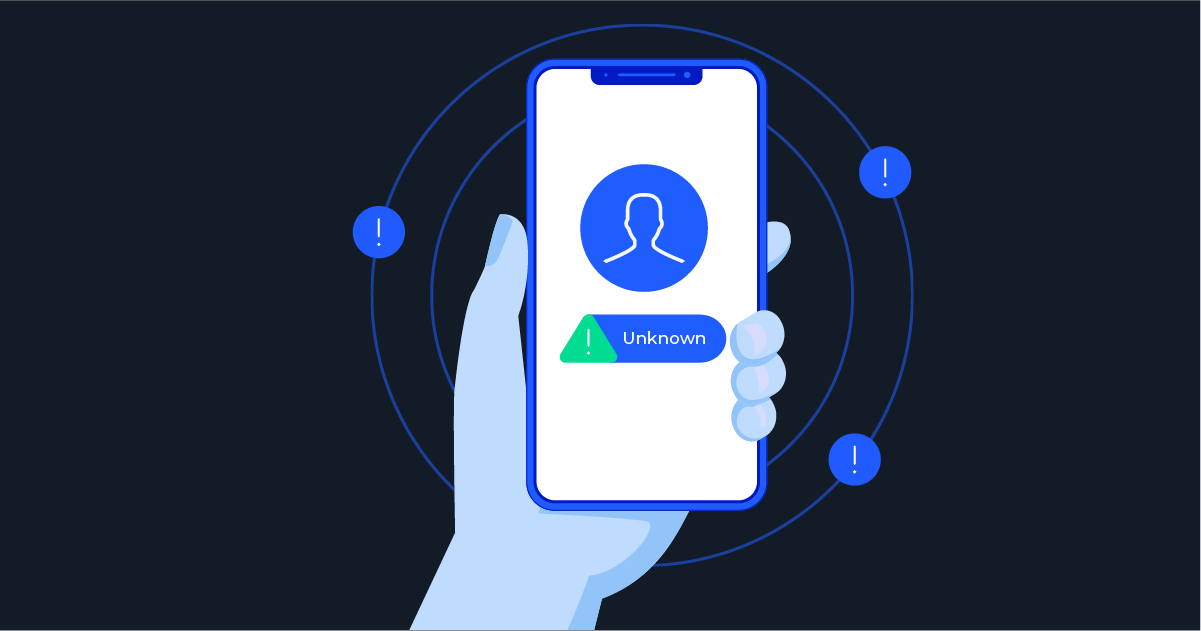
Phone number validation plays a crucial role in identity verification and fraud prevention. Consumers expect brands to protect their digital privacy—87% demand strong security measures, and 38% would stop doing business with a company after a security breach. Additionally, two-thirds of consumers report that fraud incidents damage their trust and loyalty toward the brand.
Without validating phone numbers, businesses may face risks such as fraudulent accounts, failed communications, and potential regulatory compliance issues. To address these challenges, many companies rely on phone number validation services as part of their digital risk mitigation and identify verification process to authenticate customers, reduce fraud, and enhance customer experience.
Telesign’s Phone ID API provides a multi-layered approach to phone number validation, combining real-time data analysis, risk recommendations, and identity verification. By leveraging this technology, businesses can strengthen security, maintain customer trust, and prevent fraud before it happens.
This blog covers key topics related to phone number validation—from its importance and best practices to emerging trends and AI-driven advancements. We’ll also take a deep dive into Telesign’s phone number validation solution, its technical specifications, and how businesses across industries can integrate it seamlessly.
Table of Contents
What is phone number validation?
Phone number validation is a type of identity verification that ensures that your customer can access the phone number they provide. It employs a multi-faceted approach to help assess the legitimacy and risk associated with a phone number.
Key aspects of phone number validation include:
- Format verification: Ensuring the phone number follows the correct format for its country of origin.
- Carrier lookup: Identifying the mobile carrier associated with the number.
- Phone type detection: Determining whether the number is a mobile, landline, or Voice over Internet Protocol (VoIP) number.
- Risk analysis: Analyzing the risk of a phone number based on factors like usage history, activity, and association with fraudulent behavior.
- Number portability checks: Detecting recent number porting, which can indicate fraudulent activity.
These components are essential when businesses validate a phone number to strengthen identity verification and reduce fraud risks.
How does phone number validation work?
To verify phone numbers, the phone number validation process involves a series of checks to determine whether a phone number is legitimate, active, and reachable. The typical steps include:
- Format validation
This step checks the phone number’s syntax, ensuring it follows the correct format for its country (e.g., correct number of digits, proper use of country and area codes). This is a simple, rule-based check.
- Number type identification
Determines whether the number is a mobile, landline, VoIP, or toll-free number—an essential factor in mobile identity verification.
- Luhn algorithm check
Uses the Mod 10 Check, applying the Luhn algorithm (a checksum formula) to detect typos in number sequences. While this method is primarily used for credit card validation, it can sometimes be applied to phone numbers that follow certain patterns.
- Carrier lookup (HLR/NP lookup)
- Home Location Register (HLR) lookup: Queries the HLR database of mobile network operators (MNOs) databases to retrieve:
Number status: Active, inactive, or disconnected.
Carrier information: The current MNO associated with the number.
Roaming status: Whether the number is currently roaming.
- Number Portability (NP) lookup: The phone number lookup that checks whether the number has been ported from one carrier to another.
- Reachability test (optional)
Sends a short message to the number to confirm that checks whether the number has been ported from one carrier to another.
Difference between basic validation, phone number intelligence, and risk analysis
Let’s take a close look at what each of these terms means:
- Basic validation: The process of verifying that data meets specific criteria or rules to ensure its accuracy, consistency, and quality. This process is crucial for maintaining data integrity and preventing errors in various applications, including forms and databases.
- Phone number intelligence: Intelligence involves analyzing phone numbers to gather insights for identity verification, fraud protection, and authentication. It uses various telecom signals to assess the legitimacy and potential risk associated to a phone number.
- Risk analysis: A systematic process used to identify and evaluate potential risks that could negatively impact an organization’s operations and objectives. It helps businesses understand their exposure to digital threats and make informed decisions on addressing them.
| Feature | Basic validation | Phone number intelligence | Risk analysis |
| Purpose | Ensure data accuracy and consistency | Enhance identity verification and fraud protection | Identify and manage organizational risks |
| Scope | Data quality checks | Phone number analysis for verification and fraud | Organizational risk management |
| Key techniques | Data type, range, and format checks | Phone number blacklists, carrier lookups, risk scoring | Risk identification and evaluation |
| Application | Forms, databases, client/server-side validation | Identity verification, fraud protection, authentication | Business operations, strategic planning |
Why businesses need phone number validation solutions
Thwart fraud and enhance security
Help prevent identity misuse: Can reduce the risk of unauthorized accounts being created using stolen or fabricated identity information to create fake accounts or access sensitive information.
Support account protection efforts: It adds a layer of security that helps safeguard customer accounts from unauthorized access.
Identify unusual patterns associated with synthetic identities: Helps flag activity that may indicate the use of synthetic identities.
Reduce errors and boost data quality
Phone number validation is essential for maintaining the integrity of customer databases. By using phone number verify services, businesses can reduce communication errors, improve marketing effectiveness, and maintain a clean, accurate database.
As businesses receive phone numbers, verifying phone numbers ensures greater accuracy and overall data quality.
Streamline customer onboarding and improve overall experience
A seamless onboarding process is crucial for retaining customers and building trust. Phone number validation simplifies registration by confirming the legitimacy of user-provided numbers upfront, reducing unnecessary barriers and verification steps.
This helps ensure that genuine customers can quickly and efficiently create accounts, fostering a positive experience while maintaining robust security protocols. By removing delays and streamlining user interactions, businesses can strike the right balance between convenience and protection.
Meet compliance and regulatory needs
Adhering to applicable data protection laws and regulations is another key advantage of phone number validation.
These laws and regulations require accurate identity verification to safeguard sensitive information. Phone number validation helps businesses meet these standards by verifying customer data integrity, avoiding fines, and promoting trustworthiness in global markets.
This compliance not only mitigates legal risks but also reinforces a company’s commitment to secure operations.
Enhance operational efficiency and reduce cost
Fraudulent activities often result in costly chargebacks, disputes, and additional security measures. By incorporating phone number validation, businesses can reduce the likelihood of these issues.
Validating numbers minimizes resource allocation for manual remediation efforts and supports fraud mitigation processes, allowing companies to optimize their budgets while maintaining efficient workflows. This preventative strategy supports both long-term sustainability and enhanced profitability.
How Telesign’s phone number validation solution works
Here are the key features of Telesign’s Phone ID API for phone number validation:
- Phone type detection
Identifies the type of phone number, distinguishing between mobile, VoIP, landline, and other categories. Knowing the phone type enables businesses to tailor their communication strategies and optimize delivery channels.
For example, businesses may prioritize SMS messages for mobile numbers or adjust communication security protocols based on the identified phone type. This SMS phone number validation helps in reducing communication costs and improving engagement rates.
- Carrier and region identification
Determines the current carrier associated with the phone number and its country of origin. Identifying the carrier enables businesses to optimize message delivery routes and assist with regional compliance regulations.
This information is crucial for understanding the geographic distribution of your customer base and can inform localization strategies for marketing and customer support. Knowing the country of origin also aids in fraud prevention by flagging numbers from high-risk regions.
- Real-time risk analysis
Leverages machine learning (ML) to analyze phone numbers in real time and identify potential associated fraud risks. This feature helps businesses proactively detect suspicious activities, such as disposable numbers or numbers associated with fraudulent accounts.
The real-time analysis allows for immediate action by the business, such as blocking suspicious transactions or triggering additional verification steps. This minimizes potential financial losses and protects your platform from abuse.
- Number portability checks
Verifies the accuracy of phone number information by checking for recent porting activity, ensuring you have the most up-to-date data. Accurate data improves message delivery success, improving delivery rates and reducing wasted resources.
Knowing if a number has been ported also allows businesses to maintain accurate customer records and avoid compliance issues related to sending communications to the wrong recipient.
- Activity and tenure insights
Offers insights into recent activity and usage patterns associated with the phone number, providing valuable context for risk assessment. Understanding how long a phone number has been active and its recent usage patterns can help distinguish legitimate customers from potential fraudsters.
This information can be used to identify anomalies and trigger additional security measures for high-risk accounts.
- AI-powered risk recommendations
Employs advanced analytics and ML to generate risk recommendations, helping businesses identify and mitigate potential fraud attempts. This risk recommendation is based on a multitude of factors, including phone type, carrier information, activity patterns, and historical data, providing a holistic view of the potential risk associated with a phone number.
Risk recommendations help businesses to prioritize security measures and allocate resources effectively, focusing on the most suspicious numbers.
Technical specifications of Telesign’s phone number validation solution
API availability
REST API for seamless integration that enables seamless integration with existing systems, allowing businesses to incorporate phone number validation into their workflows easily. It facilitates rapid deployment and scalability across various applications.
Response time
Real-time processing within milliseconds ensures that phone number validation does not delay customer onboarding or transaction processing, maintaining a smooth user experience. It supports high-volume transactions and rapid decision-making processes.
Data sources
Carrier databases, global numbering plan data, and ML models. Combines diverse data sources to provide comprehensive insights into phone number legitimacy and risk.
- Carrier databases: Utilizes data from telecom carriers to help validate phone numbers and assess subscriber information.
- Global numbering plan data: Leverages international numbering standards to support accurate phone number formatting and validation.
- ML models: Employs advanced algorithms to analyze phone number attributes and may detect potential fraud risks.
Integration options
It supports JSON and XML responses for flexible deployment by integrating them with different systems and programming languages, making it easier for developers to deploy the solution. It accommodates various technical environments and development frameworks.
Security and compliance standards
AES-256 encryption for secure data transmission and compliance certificates such as SOC 2 compliance and ISO 27001 certification. It helps to protect sensitive data during transmission and storage, adhering to rigorous security standards.
The role of AI & machine learning in phone number validation
AI and machine learning play an increasingly important role in the future of digital fraud prevention by enhancing phone number validation. These technologies support risk detection, improve fraud protection, and strengthen customer identity verification software. Here’s how AI and ML are transforming phone number validation:
AI-powered analytics for improved risk detection
AI-powered analytics play a crucial role in enhancing risk and fraud detection by analyzing vast amounts of data associated with phone numbers. Many customer identity verification software solutions already incorporate these systems to enhance security.
AI models can identify patterns that may indicate fraudulent activity, such as unusual call behavior or sudden changes in phone number usage. By recognizing these anomalies, businesses may proactively detect and mitigate risks.
Behavioral analytics in phone number risk recommendations
Behavioral analytics involves analyzing user behavior patterns linked with phone numbers to analyze potential risks. This includes monitoring call activity, messaging patterns, and other usage metrics to detect suspicious behavior.
ML models for continuous adaptation
ML models are designed to evolve and adapt to changing patterns in user behavior. By learning from historical data and continuously updating their algorithms, these models stay ahead of emerging threats. As fraud tactics become more sophisticated, ML-driven systems can quickly recognize and respond to new attack patterns, ensuring ongoing security in verifying a phone number.
Future of identity verification with AI-driven phone intelligence
AI-driven phone intelligence is expected to continue to shape the future of customer identity verification software, offering more advanced fraud detection capabilities. Some key developments to expect include:
- Integration with The Internet of Things (IoT) devices: AI-driven phone intelligence will likely integrate with IoT devices, creating a more comprehensive verification process.
- Real-time monitoring: AI systems can support the analysis of user behavior in real-time, detecting and responding to suspicious activities immediately.
- Improved security protocols: Artificial Intelligence will help develop stronger security measures to counteract AI-driven fraud attempts, ensuring that verification processes remain effective
Key trends in phone number validation
Here are the key trends shaping phone number validation in 2025:
AI-driven fraud prevention: Artificial intelligence is becoming essential in fraud prevention strategies. It enhances phone number validation by enabling smarter, faster risk assessment and helping businesses detect suspicious activity before it escalates.
Passwordless authentication as the new norm: With a growing emphasis on frictionless user experiences, passwordless authentication—often powered by phone verification—has become a standard part of mobile identity verification APIs. It offers both convenience and security in a single step.
Rise in phishing and social engineering tactics: As digital threats become more sophisticated, phishing attacks are increasingly targeting mobile communication channels. This may encourage businesses to strengthen their phone number validation workflows to protect user accounts.
Emphasis on mobile security awareness: Organizations are prioritizing education and awareness efforts to help users recognize and respond to threats. Phone number validation plays a supporting role by flagging potentially risky numbers and preventing exploit attempts.
Regulatory pressure shaping verification standards: Global regulations are driving businesses to reassess and improve how they verify a phone number. Compliance requirements now demand greater accuracy, transparency, and accountability in digital identity verification practices.
Wider adoption of mobile identity verification APIs: Businesses across sectors are integrating mobile identity verification APIs into their platforms to reduce fraud, enhance onboarding, and build long-term user trust.
Challenges from number spoofing and virtual numbers: The rise of VoIP and number masking technologies has made fraud detection more complex. This has led to broader adoption of advanced phone number validation to uncover anomalies and protect against spoofed identities.
Shift toward proactive security strategies: Instead of reacting to breaches, businesses are building proactive defenses by layering phone number intelligence, risk analysis, and real-time monitoring into their verification processes.
These trends in phone number validation reflect the evolving needs of both users and businesses—and the growing importance of secure, intelligent identity verification in today’s digital ecosystem.
By staying ahead of these trends, businesses can leverage Telesign’s Phone ID API to validate phone numbers and ensure compliance, security, and seamless customer interactions.
What are the best practices for effective phone number validation?
Following best practices is essential to check if a phone number is valid and ensure accuracy in your verification process.
- Validating new customer enrollments: During sign-up, collect the customer’s phone number through an input field, then validate phone numbers to confirm they are legitimate. Finally, verify the phone number to ensure the user can actually access it.
- Place the country code in a distinct field: Use a phone number validation service with an intuitive interface that supports mobile number validation across global formats. Always separate the international dialing code and format numbers using the standardized E.164 format
- Format phone numbers in E.164: The E.164 format ensures globally unique identifiers for every phone number. When using Telesign’s API for mobile number validation, convert all entries into this standard format to maintain accuracy and compatibility.
- Send a one-time password (OTP): OTP-based cell number verification confirms that the user has access to the submitted phone number. It prevents misuse, such as submitting someone else’s number, and ensures message deliverability for future communications and authentication.
- Check for line type: For effective telephone number validation, identify the number type—mobile, landline, or VoIP. This helps tailor messaging channels to maximize delivery rates and conversion.
- Use multi-layered verification: Combining several mobile phone verification methods—like format checks, carrier identification, and OTP delivery—for robust, multi-layered verification. This layered approach ensures accurate results and strengthens customer identity verification. Telesign’s SMS Verify API can be integrated with phone number validation tools for comprehensive protection.
- Build retry logic into phone verification interface: Users may enter incorrect information or fail to complete verification on the first attempt. Incorporating retry logic improves UX. For example, after multiple OTP requests to the same number within a short window, Telesign’s Verify API rate-limits attempts to protect against abuse.
What are the most common applications of phone number validation?
Here are the top use cases and case studies of phone number validation that Telesign delivered successfully across the following verticals:
E-Commerce and Online Marketplaces
Case study #1: AstroPay Improve customer onboarding and Reduces Fraud
Here are the use cases for AstroPay:
- Combatting fake account creation: AstroPay faced challenges with fraudulent account creation, leading to promotion abuse. By integrating Telesign’s Intelligence API, they assessed the risk level of new customers during onboarding.
- Improving SMS deliverability: AstroPay utilized Telesign’s SMS API to enhance message deliverability for one-time passcodes (OTPs) and notifications.
AstroPay successfully increased the ratio of active accounts while optimizing promotional costs by reducing fake accounts. Also, with Telesign’s SMS API offering a comprehensive digital identity verification solution, the company achieved better SMS deliverability, ensuring timely communication with customers.
Financial Services and Fintech
Case Study #2: Amount streamlines onboarding and verification
Here are the use cases for Amount:
- Customer onboarding: Amount integrated Telesign’s solutions to streamline their customer onboarding process. Automating customer verification reduced friction during sign-up, making it easier for legitimate customers to access services quickly.
- User verification: Improved user verification processes helped prevent fraudulent account creation. By validating phone numbers in real-time, Amount could filter out potential fraudsters before they could engage with their services.
By leveraging Telesign’s technology, Amount improved the efficiency of onboarding new customers while reducing the risk of fraudulent account creations. This ensured a smoother and seamless experience for both businesses and their users.
Enterprise Software and SaaS
Case Study #3: Salesforce enhances account security
Here are the use cases for Salesforce:
- User authentication: Integrated Telesign’s verification solutions to authenticate users accessing the platform.
- Preventing unauthorized access: Strengthened security measures to protect user accounts from unauthorized access.
Salesforce improved its security infrastructure, reducing instances of unauthorized account access. This integration significantly strengthened platform security, providing users with a more secure and seamless experience.
Gaming and Entertainment
Case Study # 4: Ubisoft ensures secure gaming experiences
Here are the use cases for Ubisoft:
- Account security: Ubisoft implemented Telesign’s verification solutions to secure user accounts against unauthorized access and fraud. This step was critical in maintaining player trust within their gaming ecosystem.
- Fraud protection: By reducing fraudulent activities within the gaming platform through effective phone validation measures, Ubisoft created a safer environment for players to enjoy their games without fear of cheating or scams.
By integrating Telesign’s security solutions, Ubisoft significantly enhanced the security of gamer accounts, creating a safer gaming environment. This implementation reduced fraudulent transactions and protected players from unauthorized access.
How to integrate Telesign’s phone number validation API?
Integrating Telesign’s Phone Number Validation API into your systems is a straightforward process that helps enhance security and reduce fraud risks.
Businesses can seamlessly integrate this robust solution to verify phone numbers globally by following these simple steps.
Step 1: Sign up for API access
Start by registering on portal.telesign.com to obtain API access. After creating your account, you will be provided with a Customer ID and API key, which are essential for integration.
Step 2: Retrieve your API key
Once your account is active, log in to your developer dashboard to retrieve your unique API key. This key will authenticate your requests to the API.
Step 3: Make an API request
Telesign’s API supports multiple programming languages, including Python, Java, and PHP, allowing developers to work with their preferred frameworks.
You can send an API request using the REST interface to validate a phone number’s format, carrier, type, and more.
For example:
“`json
{
phone_number: +1234567890
}
“`
Step 4: Interpret the response
The API returns detailed data, including whether the number is active, its type (mobile, VoIP, or landline), and its associated carrier. It also provides a risk score to flag potentially fraudulent numbers.
Use this information to make informed decisions about customer onboarding and security protocols.
Step 5: Implement risk-based decision making
Utilize the validation results to create customized workflows. For instance, block high-risk numbers, request additional verification for suspicious accounts, or approve genuine numbers for seamless onboarding.
Telesign’s API ensures businesses can check if a phone number is real while adhering to international privacy regulations.
It supports global validation, making it an effective solution for preventing fraud and improving security.
With Telesign, businesses can confidently differentiate between phone number validation (checking functionality) and verification (proving ownership).
Telesign’s Phone ID API offers an advanced phone number validation tool powered by AI-driven risk assessment, ensuring mobile number verification and enhanced fraud protection.
FAQ
The best phone number validation API depends on your specific needs and budget. Popular options such as Telesign offer top features and competitive pricing. Remember to evaluate factors like accuracy, global coverage, and ease of integration to choose the optimal API.
You can check if a phone number is real by using a phone number validation service. These services verify the number’s format, active status, and carrier information, ensuring it’s a valid and reachable number.
Using unverified phone numbers can lead to increased fraud, spam, and inaccurate data. It can also result in wasted resources and a damaged reputation due to failed communications and potential security breaches.
Phone number validation protects fraud by verifying the authenticity of phone numbers used in transactions. It identifies suspicious numbers and helps prevent scams and unauthorized access by reducing the risk of fake accounts and fraudulent activities.
Phone number validation enhances security by confirming the legitimacy of users during registration and authentication processes. This reduces the risk of account takeovers, prevents fraudulent activities, and protects customer data by ensuring that only verified numbers are associated with accounts.
Yes, Telesign can validate international phone numbers. They offer global coverage and support for verifying phone numbers across a wide range of countries and regions.
Phone number validation checks whether a number is in the correct format and potentially working. Phone number verification confirms that the phone number belongs to the user by sending a code via SMS or voice call.



